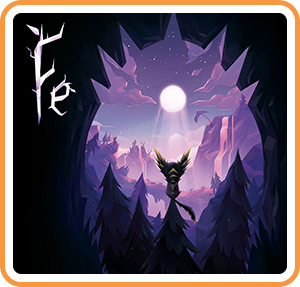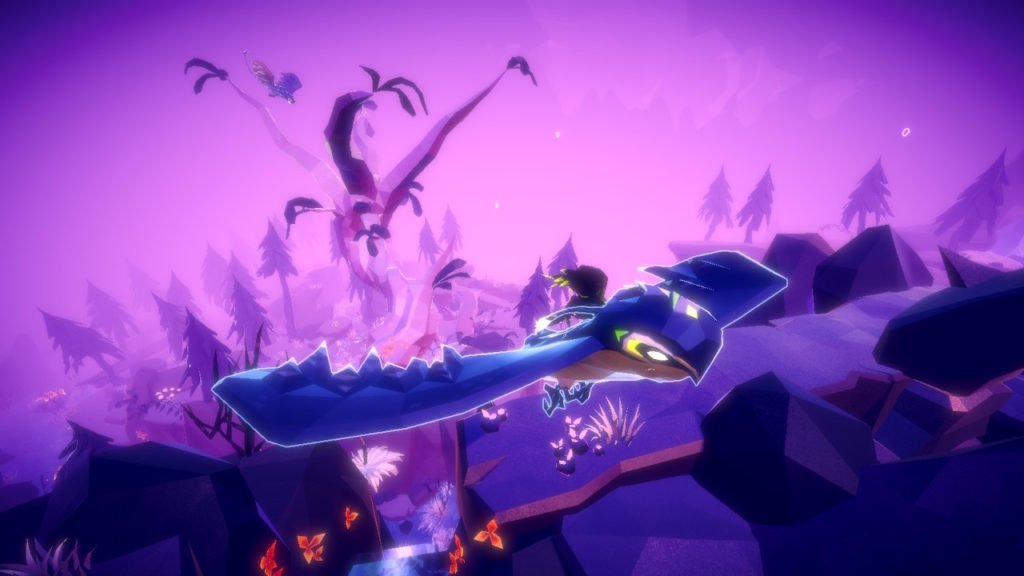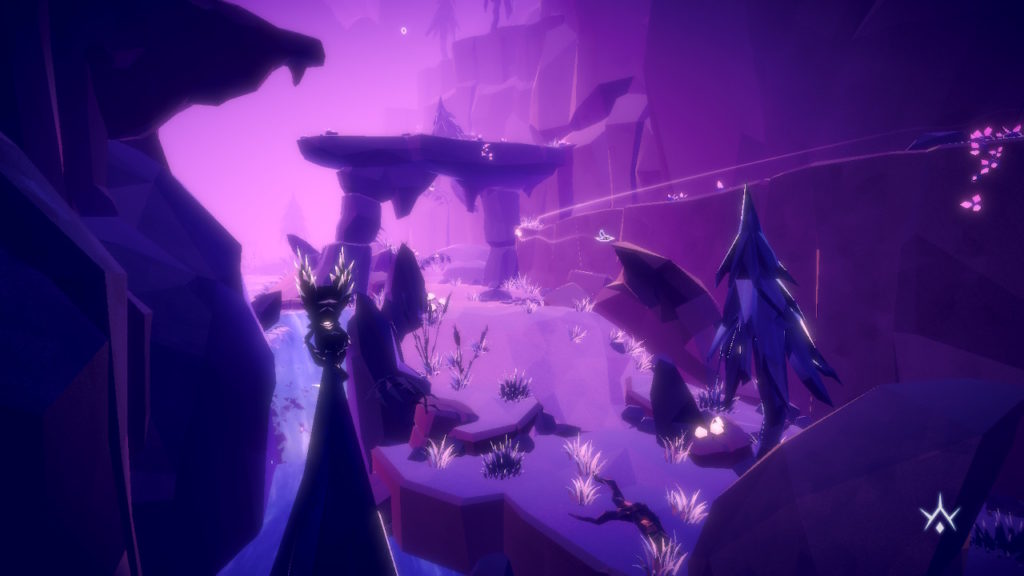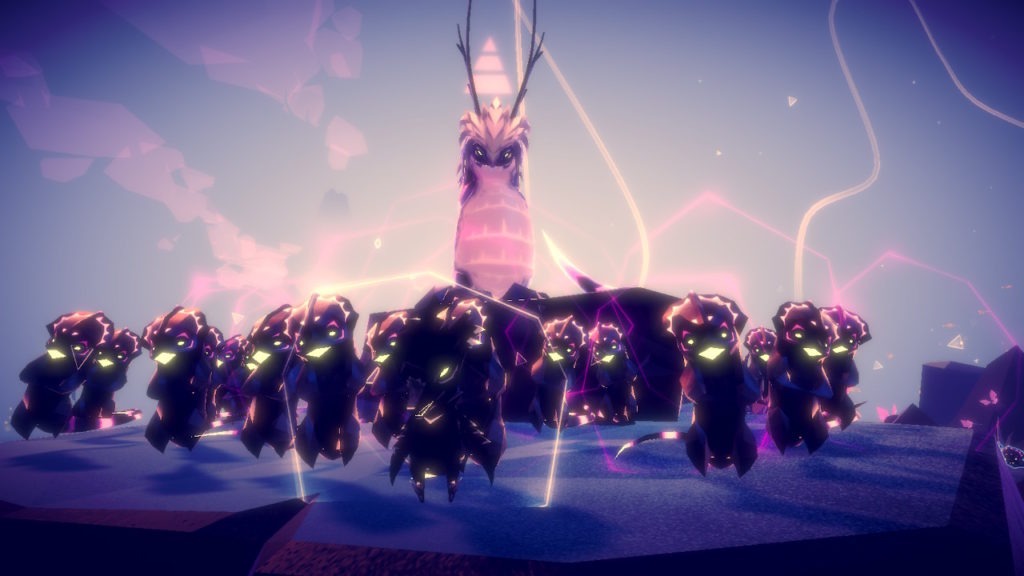
Fe really is something magical.
No, we’re not just talking about how inviting yet mysterious the purple-hued forest looks. That’s already been established through numerous promotional screenshots. We’re not just talking about the intriguing concept of singing to animals and plants, either. No, we’re talking about the entire experience, from beginning to end, of how Fe manages to captivate and mystify you.
The forest: our new home.
Fe begins with a small cinematic showing the forest and some of its inhabitants, before showing five bolts of something approaching a mountain at high speed. One by one, the bolt will stop on its track, momentarily revealing a creature before plummeting down to the ground. The screen flashes white by the time the last two hit the ground.
When we finally get control of the game, we find out that the five flying creatures are actually a group of identical… well, creatures. It’s not really explained who or what they are, nor do we ever find out where they were really going and what made them fall. What we do know is that they’re small, they look like a fox with sharp chompers, and they can sing. They seem to be in tune with their surroundings, and through us, as players, they can be a bit curious.
It is also during these first few moments that we learn how the game presents itself – an open-world exploration with bits of Metroidvania aspects sprinkled in. There are flowers around that cower in fear whenever they hear the wrong song, reinforced with the giant translucent “X” that appears. Some paths have something sinister-looking blocking them. And most importantly, there are trees all over the place that seem accessible, especially on higher terrain.
But we don’t have to worry about that in the meantime. There’s a younger deer ahead that will string us along across the forest. And this is when the game implies, but never explicitly states, that we can either diverge from the deer’s path and let our curiosities take us to new places, or follow the deer (and eventually a guiding bird) to experience the forest as prescribed. This freedom, along with markers on the mini-map, hands us the keys to our enjoyment. Do we want to explore and take things on our own time, or do we want to be on a guided tour?
A concert in the forest.
Eventually, we get the chance to sing to animals and plants – a way of befriending the creatures of the forest. Each creature will briefly display a symbol on their head, which is an indication of which song must be used before they respond. Some younger creatures will respond to your default song, which ranges from a throaty growl, a toddler-like babbling, all the way up to a child-like howl. Sing on the same wavelength by carefully rocking any motion-enabled controller back and forth or by tilting the right stick at a precise spot.
Learning how to control Fe’s singing voice is the main concept to remember. Some animals only respond to gentle singing, while some respond to louder voices. A lot of the obstacles rely on this main singing mechanic, and depending on which scheme you use, this can cause some annoyance. The motion control is a bit cumbersome when playing on handheld, and it can also be a bit inaccurate when playing in docked mode using a Joy-Con or Pro Controller.

Controlling the songs with the right stick is easier but not without its problems. Because the camera is bound to the right stick, trying to pinpoint the proper song wavelength and holding it there can cause the camera to rotate while singing. The song matching moments are not long – only about three seconds at most – but their frequency means that your view will be spinning several times.
Thankfully, not a collect-a-thon.
There are also the pink crystals to collect around the forest, which are used to unlock helpful but optional skills. Most of them are hidden away from the beaten path, requiring you to truly poke your nose around in order to find them. Some of them are inaccessible until you come back later with another skill. Thankfully, there are enough crystals around the forest that are out in plain sight, ensuring access to useful skills that require fewer crystals.
And because Fe, the creature is such a small thing, most of the exploration involves us going upwards. The forest is truly deep, encircled by tall peaks and soaring trees, and we must make our way up. Our earliest skill, the tree climbing, unlocks a large part of the forest for us. Climb any tree and sit on top in order to reach far platforms, or just to look around and find something out of sight. Not only is it a picturesque way to observe the surroundings, but it’s also a great vantage point when trying to find your next destination.

Unfortunately, this is where things get a bit clunky. Because Fe automatically grabs a part of a nearby tree, repeatedly pressing B will not only speed up your climbing but also launch you off once on top. When paired with the finicky inaccuracy of the gliding skill, hopping from tree to tree with a purpose turns into a rather scary affair.
Climbing back up, if you do fall from a great height is another struggle. Even though you don’t die from your fall unless you get eaten by a giant fish, trying to find your way back up is a chore in itself. Fe can’t scale walls and the jumping height is awful, so we must rely on flowers to bounce and propel us upward. But because the game can look too beautiful for its own good sometimes, it can be hard to tell which surface is safe for landing and which one is a slippery slope.
Our bigger purpose.
And the story? Well, this is where it all gets a bit shaky. We do have some baddies around in the form of one-eyed golems. They seem to be capturing any animal they spot and burning them for energy. Who are they and what are they doing? There are boxes around that dislodge some memory orbs after Fe wails in front of it for a few seconds, but even these are not helpful. They simply show a flashback through the eyes of a golem, doing things that we already see them doing.
What we do know is that they are clearly hurting the animals, and this is where player-controlled Fe comes in. Through various tasks – freeing a captured animal, bringing babies back to their parents, removing evil influence of an animal, etc. – we liberate each animal kingdom and their homes one by one. We also learn new songs from them, allowing us to enlist their help or utilize specific flowers when necessary.

But once that’s done, there not much left to do other than to get rid of the pesky golems. Their corruption against the forest goes away and everything is happy again. But is that really our purpose for landing in the forest? What are the golems really after? Nobody knows.
Settling in.
Fe the game is not really concerned in explaining anything, but that’s probably because it wants us to focus on the now. It wants us to get lost in the forest and be one with it. To learn of its secrets and to befriend its citizens. To fail and get eaten by a giant fish and to try again. It focuses heavily on the experience so that you don’t have to worry about the lore.
And in a way, that’s refreshing. To be able to lean back during a weekend and enjoy a gorgeous game without worrying about an overarching narrative is relaxing. To be serenaded by haunting string compositions is just icing on the cake. Fe is definitely a well-packaged experience, even down to the bow that ties everything together.
Review Copy Provided By Zoink Games









